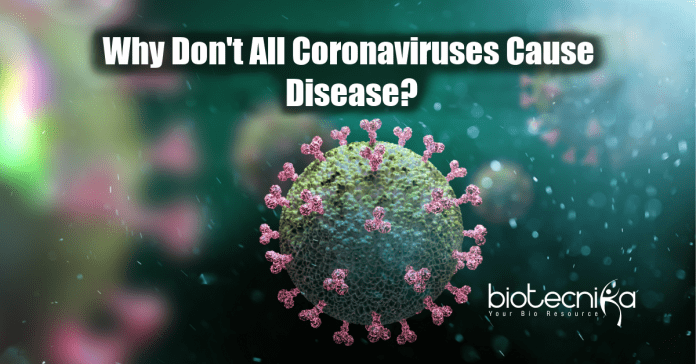Why don’t all coronaviruses cause disease? Scientists explain possible reasons
COVID-19 is caused by SARS-CoV-2, a type of coronavirus that causes infection in the respiratory tract by entering the body through the nose, mouth, or eyes. SARS-CoV-2 is not the first coronavirus that has caused disease in human beings. There are several non-pathogenic coronaviruses and at least 4 types of typical cold-causing coronaviruses, SARS-CoV, and MERS-CoV.
Currently, a team of researchers at the University of Alabama, Birmingham said that they have discovered a possible reason why some coronaviruses just cause the common cold, and some may not even trigger any disease, but novel coronavirus – SARS-CoV-2 is pathogenic.
The outcomes for the research are released in the American Journal of Physiology – Lung Cellular and Molecular Physiology, and the study suggests that SARS-CoV-2 acts as a miRNA (microRNAs) sponge and damages the host immune system, which allows viral replication as well as the disease spread.
MiRNAs and viral sponges
MiRNAs are short stretches of RNAs helping in the production of different proteins and help in fine-tuning cellular metabolism rate and the response of a cell to adverse challenges like stress or viral entry. It constitutes just 0.01% of the total
RNA in a cell. But, viral RNA constitutes about half of the total RNA in a cell throughout a viral infection.In Epstein Barr infection, hepatitis C, and herpes virus, the concept of viral sponges has previously been noted. Viruses sponge up miRNAs by binding to them at different sites, a viral sponge can inhibit the miRNA of the cell from working – This makes the host cell unable to express specific proteins that can otherwise help it to eliminate the virus.
The latest study
In the current research, the scientists utilized computer analysis and bioinformatics to find out the interaction between the 896 miRNAs in humans, 7 coronaviruses – the most pathogenic ones: SARS-CoV, MERS-CoV and SARS-CoV-2, and 4 non-pathogenic coronaviruses.
The scientists discovered that compared to the non-pathogenic strains, all 3 pathogenic strains had many more miRNA binding sites, SARS and MERS virus had a unique set of 21 and 24 miRNA binding sites, respectively, and SARS-CoV-2 had a set of 28 distinct miRNA binding sites.
The epithelial cells of the bronchi – mainly associated with lung problems like lung cancer, cystic fibrosis, and tuberculosis expresses these miRNAs – that SARS-CoV-2 effects.
The authors of the study said that the COVID-19 virus – by its potential reduction of the host’s miRNA pool – may promote infected cell survival and therefore continuity of its replication cycle.
Additionally, it was shown that among other things that this virus needs to perpetuate in the body, about 9 of the 28 miRNAs sponged by the COVID-19 causing virus have a role in inhibiting the production of host cell proteins and viral duplication.
Future prospects
The scientists claim that these findings will require additional validation, consisting of examining the levels of the target miRNAs in host cells and tissues. This might help in developing new treatment methods involving miRNAs balancing.
The study might help shed light on why some individuals are more susceptible to severe COVID-19. Previously, it has been suggested that the severity of the disease in older people is due to the fact that older people have lesser miRNAs.
Additionally, it might help understand how this virus can exist both in humans and animals – There are specific miRNAs in bats that provide tolerance to COVID-19 causing virus.
Author: Sruthi S






























